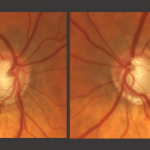While hypertension affects the entire body, it has specific effects on the health of the eyes. The primary effects of hypertension are found in the back of the eye, in the retina.
High Blood Pressure Causes Changes in the Retina
The retina is saturated with small blood vessels, called capillaries, which supply it with the oxygen needed to function properly.
The retina is responsible for capturing light and signaling the brain to begin the process of vision. This process requires a high amount of oxygen from the vessels in the retina and makes the retina susceptible to damage from hypertension.
There are many ways which hypertension can damage the retina including: cause hemorrhages, cotton wool spots, and vessel occlusions.
The Common Hypertension Eye Findings
One of the most common findings with hypertension is hemorrhages. These occur when a vessel in the retina ruptures and the blood spills into the surrounding tissue.
Fortunately, most hemorrhages resolve on their own and do not affect vision. However, the presence of many hemorrhages often signifies higher risk of more damage.
Another common finding with hypertension is cotton wool spots. These are portions of the retina which appear white and have rounded edges when viewed by an optometrist or ophthalmologist, thus the name cotton wool spots.
These spots no longer have active blood flow due to damage to the vessel that provided the blood to that area. Like hemorrhages, by themselves cotton wool spots do not cause vision loss.
Among the most severe findings with hypertension is a vessel occlusion. An occlusion occurs when there is a complete blockage of a primary vessel in the retina.
Unlike hemorrhages and cotton wool spots, occlusions are associated with a loss of vision or decrease in vision in the affected area.
Managing High Blood Pressure Takes a Team Approach
The best ways to ensure good eye health with hypertension is to have regular eye exams with your optometrist and to follow the management coordinated between your eye care and primary care providers.




0 Comments